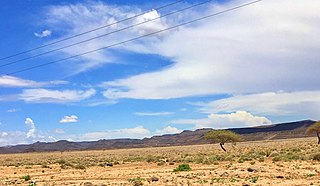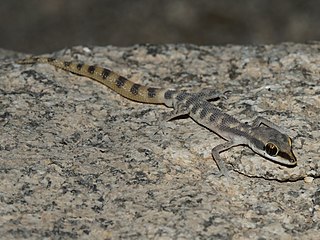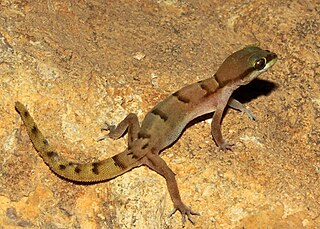
Tropiocolotes is a genus of geckos, lizards in the family Gekkonidae. The genus is native to North Africa and the Middle East. Species in the genus Tropiocolotes grow to a total length of about 2 in (5.1 cm). They are commonly known as dwarf geckos, pygmy geckos, or sand geckos. They have an elongated body and the head is oval and of equal or lesser width than the body.

The Djibouti xeric shrublands is an ecoregion defined by One Earth, consisting of a semi-desert strip on or near the Red Sea and the Gulf of Aden coasts in Eritrea, Ethiopia, Djibouti and Somalia. This ecoregion lies mainly between sea level and 800 meters (m) elevation. There are, however, many hills and massifs, which range up to 1300 m as well as outstanding fault-induced depressions, such as the Danakil, lying as low as 155 m below sea level. This region is extremely active tectonically, experiencing many earthquakes and intermittently active volcanoes. Rainfall is very low and yearly averages range from 100 to 200 millimeters (mm), with less rain falling closer to the coast. There are many species of interest, including the endemic Archer's lark, a species of dragon tree, and a large suite of desert ungulates, including the last viable population of African wild ass.

The Grand Bara, Bara Wein or Bada Wein, is a desert in southern Djibouti. It consists of large areas of sand flats, with sparse, semi-desert and desert grasses and scrub vegetation. A road built in 1981 passes through the area, connecting the capital Djibouti City with the south. Prior to the arrival of the French, the extremely arid interior was inhabited primarily by the Issa Somali. Runners make their way across the Grand Bara Desert during the Annual Grand Bara 15K race.
The northern Somali leaf-toed gecko is a species of gecko. It is found in Somaliland and Ethiopia.
The Somali dwarf gecko is a species of gecko found in northern Kenya, Somalia and Ethiopia.

The Bishari dwarf gecko is a species of gecko of the genus Tropiocolotes. It is found in Egypt. The specific epithet bisharicus refers to the Bisharin tribe, which lives in the same region as this species.
Tropiocolotes hormozganensis is a species of gecko of the genus Tropiocolotes. It is found in the Hormozgan Province, Iran. The specific epithet hormozganensis relates to the type locality, the Hormozgan Province.
Tropiocolotes naybandensis is a species of gecko of the genus Tropiocolotes. It is found in the Bushehr Province, Iran. The specific epithet naybandensis relates to the type locality, which is near the Nayband Gulf.

The Steudner's gecko is a species of gecko of the genus Tropiocolotes. It is found in Egypt and Sudan. The specific epithet nubicus relates to the type locality, the Nubia Region. 'Steudner' may relate to the German botanist and explorer Hermann Steudner (1832-1863).
The low-lying gecko is a species of lizard in the family Gekkonidae. The species is endemic to western Pakistan.
Microgecko helenae, also known commonly as the banded dwarf gecko, Helen's banded dwarf gecko, Helen's tiny gecko, the Khuristan dwarf gecko, and the Khuzestan dwarf gecko, is a species of lizard in the family Gekkonidae. The species is endemic to Iran. There are two recognized subspecies.

Latifi's dwarf gecko, also known commonly as the Zagros tiny gecko, is a species of lizard in the family Gekkonidae. The species is endemic to Iran.
Scortecci's sand gecko, also known commonly as Scortecci's dwarf gecko, is a species of lizard in the family Gekkonidae. The species is endemic to the Arabian Peninsula.

Steudner's dwarf gecko, also commonly known as the Algerian sand gecko and Steudner's pigmy gecko, is a species of lizard in the family Gekkonidae. The species is native to North Africa and the Middle East.
Tropiocolotes wolfgangboehmei is a species of gecko of the family Gekkonidae from central Saudi Arabia. The specific epithet wolfgangboehmei honors Wolfgang Böhme for his contributions in herpetology and for being the mentor of two of the authors who described T. wolfgangboehmei.

Microgecko persicus, known as the Persia sand gecko or Persian dwarf gecko, is a species of lizard in the family Gekkonidae. The species is endemic to Iran, Iraq and Pakistan. As of January 2019 its conservation status has not been assessed on the IUCN Red List.
Tropiocolotes confusus is a species of gecko endemic to Oman. The type specimen was collected in Dhofar.

Tropiocolotes tripolitanus, also known as the northern sand gecko or Tripoli gecko, is a species of gecko found in northern Africa.
Pristurus somalicus, also known as Somali rock gecko or Somali semaphore gecko, is a species of lizard in the Sphaerodactylidae family found in Somalia and Ethiopia.







